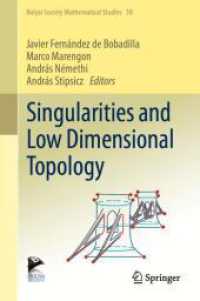- ホーム
- > 洋書
- > 英文書
- > History / World
Full Description
The Andes are of unquestioned significance to the human story: a cradle of agriculture and of 'pristine' civilisation with a pedigree of millennia. The Incas were but the culmination of a succession of civilisations that rose and fell to leave one of the richest archaeological records on Earth. By no coincidence, the Andes are home also to our greatest surviving link to the speech of the New World before European conquest: the Quechua language family. For linguists, the native tongues of the Andes make for another rich seam of data on origins, expansions and reversals throughout prehistory. Historians and anthropologists, meanwhile, negotiate many pitfalls to interpret the conflicting mytho-histories of the Andes, recorded for us only through the distorting prism of the conquistadors' world-view.
Each of these disciplines opens up its own partial window on the past: very different perspectives, to be sure, but all the more complementary for it. Frustratingly though, specialists in each field have all too long proceeded largely in ignorance of great strides being taken in the others. This book is a long overdue meeting of minds, bringing together a worldwide cast of pre-eminent scholars from each discipline. Here they at last converge their disparate perspectives into a true cross-disciplinary focus, to weave together a more coherent account of what was, after all, one and the same prehistory.
The result, instructive also far beyond the Andes, is a rich case-study in the pursuit of a more holistic vision of the human past.
Contents
Introduction - Archaeology and Language in the Andes: A Much-Needed Conversation
Archaeology and Language in the Andes: Some General Models of Change
Broadening Our Horizons: Towards an Interdisciplinary Prehistory of the Andes
Modelling the Quechua-Aymara Relationship: Sociolinguistic Scenarios and Possible Archaeological Evidence
On the Origins of Social Complexity in the Central Andes and Possible Linguistic Correlations
Central Andean Language Expansion and the Chavín Sphere of Interaction
The 1st Millennium ad in North Central Peru: Critical Perspectives on a Linguistic Prehistory
Cajamarca Quechua and the Expansion of the Huari State 155
Middle Horizon Imperialism and the Prehistoric Dispersal of Andean Languages
Indicators of Possible Driving Forces for the Spread of Quechua and Aymara Reflected in the Archaeology of Cuzco
Unravelling the Enigma of the 'Particular Language' of the Incas
Accounting for the Spread of Quechua and Aymara Between Cuzco and Lake Titicaca
The Herder-Cultivator Relationship as a Paradigm for Archaeological Origins, Linguistic Dispersals and the Evolution of Record Keeping in the Andes
How did Quechua Reach Ecuador?
Quechua's Southern Boundary: The Case of Santiago del Estero, Argentina
Conclusion - A Cross-Disciplinary Prehistory for the Andes?
Surveying the State of the Art







